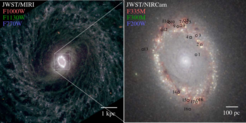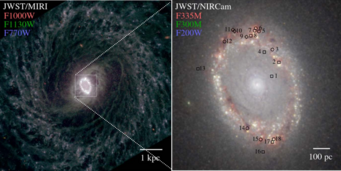ERC Advanced Grant worth over 2.4 million Euros for Eva Schinnerer
Eva Schinnerer, head of a research group in Hans-Walter Rix's Galaxies and Cosmology (GC) department at the Max Planck Institute for Astronomy in Heidelberg, has been awarded one of the European Research Council's (ERC) highly endowed and highly coveted funding awards. Their project entitled "Galaxy Centers: Understanding Star Formation in Extreme Environments" will be funded with almost 2.44 million euros as part of an ERC Advanced Grant.

In the classical picture of galaxies, increased star formation is primarily associated with large spiral galaxies such as our Milky Way system. In contrast to elliptical galaxies, spiral galaxies are characterized by an increased amount of gas and the areas of such star formation are usually located in the spiral arms - and thus rather far out at large distances of several 1000 or 10000 light years from the galaxy centers. However, with ever better observations, many gas-rich galaxy centers can also be found.
Areas such as the central molecular zone (CMZ) of our own home galaxy, the Milky Way, are among the least researched environments for star formation, but are also among the most extreme environments for this process, making them highly interesting from an astrophysical point of view. This is because these regions are influenced by large-scale gas flows, nuclear star-forming regions and/or active galactic nuclei. This makes them unique laboratories in the local universe for studying star formation at the highest gas and stellar mass concentrations, within intense radiation fields and at comparatively short dynamic timescales (<50 million years).
CMZs are quite compact with expansions of less than 1000 parsecs (1 parsec corresponds to 3.26 light years) and are subject to high extinction. This means that radiation from their interior in the visible spectral range of light is very attenuated by dust, for example, and is difficult to observe. However, things are different at longer wavelengths in the near and mid-infrared light and up to the sub-millimeter range. This is what Eva Schinnerer is exploiting in her project.

"New opportunities to decisively advance the investigation of CMZs arose on the one hand through the use of the James Webb Space Telescope (JWST), which can observe in the infrared with unprecedented resolution. Together with the ALMA telescope array in Chile, which observes at even longer wavelengths in the sub-millimetre range and which has the necessary sensitivity and spatial resolution to map the underlying gas distribution, we want to examine the data of 37 nearby galaxies from a well-characterized sample as part of the ERC project," says Eva Schinnerer.
The data were obtained as part of the PHANGS study, which she leads. PHANGS stands for "Physics at High Angular resolution in Nearby GalaxieS”. In a series of observation campaigns with ALMA, JWST and also the Hubble Telescope (HST), she had obtained an absolutely unique data set with a previously unattained spatial resolution of 5-30 parsecs in the respective centers of - cosmically speaking - relatively nearby galaxies at distances of several million parsecs.
"The detailed analysis of these data will provide the basis for further, urgently needed observations to finally test the currently discussed theories of star formation under extreme CMZ conditions. Does star formation vary on very short time scales due to the extreme local conditions? Or does the larger-scale environment of the galaxy centers regulate a rather moderate, stable star formation? These are key questions that we want to answer as part of the ERC project," says Eva Schinnerer.
The European Research Council has now provided almost 2.44 million euros for Eva Schinnerer's project. With this extensive funding, it will also be possible to flexibly set up a working group from October 2025, which could, for example, consist of positions for four postdocs over four years.
The ERC offers various funding programs as part of its program. All applications for funding must demonstrate the excellence of the scientists involved and, above all, the outstanding importance of the projects applied for.
Eva Schinnerer is a recognized expert in the field of observational extragalactic astrophysics and has been working at MPIA for many years.
Further information:
Webpage Eva Schinnerer
Press Release of the European Research Council (ERC)
Text: KJ/ES

